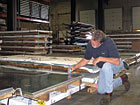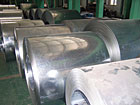
Wholesaler employees check galvanized coils for gauge thickness and zinc coating. Such steps help ensure the customer that the material delivered complies with the material ordered. (Photo courtesy of Wichita Sheet Metal Supply.)
Actual weight, theoretical weight, light-to-gauge, heavy-to-gauge, G-30 vs. G-90 - what do these terms have to do with the price you pay for galvanized steel?
The HVAC industry has always been a price-sensitive business for contractors, regardless of whether they are in the residential or commercial markets. Competition is tough. The importance of knowing your business costs accurately is more important than it’s ever been before. Contractors must be expert managers of both labor and material costs. This article will focus on materials, in particular the purchase of galvanized steel.
GRASPING GAUGE AND GALVANIZATION
First of all, let’s cover a few basics. Take “gauge,” for example. The galvanized sheet gauge used to fabricate ductwork is specified in codes and standards. Say 24 gauge is required; this could represent a galvanized sheet that is from 0.0236-0.0316 inches thick. The nominal thickness for 24 gauge is 0.0276 inches, or right in the middle between minimum and maximum. The theoretical weight of 24-gauge galvanized sheets or coils is based on nominal thickness - an important point.The zinc coating that protects steel from rusting, or “galvanizing,” is directly proportional to the weight of the zinc applied per unit area of steel sheet. The greater the weight of the coating, the greater and longer the protection. It’s that simple. The American Society for Testing and Materials (ASTM) Standard A653 stipulates that steel sheets coated with 0.9 ounces of zinc per square foot are classified as G-90. Those coated with 0.6 ounces per square foot are classified G-60. Codes and standards specify the galvanized coating required.
You can’t see or feel the difference between galvanized coatings, but job results may be decidedly different. Ordinary steel rusts quite readily if left unprotected. For this reason, steel used for HVAC duct fabrication is given a protective coating of zinc. The process is called galvanizing.
The life of this zinc coating, and therefore its protective shield, is directly proportional to the weight of the zinc applied per unit area of steel sheet. The greater the weight of the coating, the greater and longer the protection. It’s that simple.
While other coatings are possible, G-90 and G-60 are commonly included in federal specifications, other codes, and industry construction standards.
The most important factors affecting corrosion are moisture (frequency and duration), rate at which the surface dries, and the extent of marine or industrial pollution in the locality. It might take 100 years of exposure to destroy a galvanized sheet in a desert atmosphere, but in an industrial environment that same sheet may corrode in less than five years. Seacoasts also accelerate the corrosion of zinc coatings.
Ducts used for fresh air intakes, in swimming pool areas or humid basements, steel used for humidifier chambers, dishwasher exhausts, condensate pans, and similar applications, all must be carefully evaluated and the appropriate protective coating selected.

Handheld testers will give you the coating weight in a range. For an exact determination, send a sample to a testing lab.
BUYING SCENARIOS
With just these basics, let’s consider the day-to-day buying practices you might encounter:Contractor No. 1 believes he is buying actual weight on coils, but he is being billed on theoretical weight. The result can be differences in poundage, price, and material by as much as ±15 percent. The only way to verify the weight of material being received is with a scale.
Contractor No. 2 may be sold light-to-gauge, or below the minimum thickness. Light-to-gauge can result in more sheets per coils for the processor, and therefore a lower cost per sheet. However, the products being sold may not meet industry and code minimum thickness requirement for that gauge. All steel being purchased should have the actual thickness determined with a micrometer.
Contractor No. 3 encounters a product that is heavy-to-gauge. The result is a coil that, when compared to a similar coil specified at the near-nominal gauge thickness, has far less material yield, so while the 100-weight cost used for billing is less, the actual cost per square foot is more.
Contractor No. 4 might be sold something represented as a G-90 galvanized coating, yet the contractor receives G-60 or G-30/40. Cost differentials are substantial. Liabilities can be high, too, if a job is specified G-90 and something else is installed. This can result in a job being refused by an inspector or engineer, resulting in all materials being replaced at the contractor’s expense, with the loss of materials and many labor hours, plus the strong possibility of penalties.
Unstenciled sheets should always be questioned; even stenciled sheets may be suspect, depending on who is doing the stenciling. Steel mill stenciling can be relied upon, but we now find others in the supply chain applying their own stencil, and that stenciling may or may not be truthful. All steel you receive should be tested for coating weight. Handheld testers will give you the coating weight in a range; it’s usually accurate enough, but for an exact determination, send a sample to a testing lab.
“There are some resellers of steel (to both wholesalers and contractors) who have been caught both cheating and/or using deceptive sales practices,” said Arthur Franklin, president of Fairfield, N.J.-based S. Franklin & Son.
“HARDI wholesalers have found problems such as improperly stenciled steel, misrepresentations of unstenciled steel, misrepresentation of billing methods, and lack of knowledge of the subtleties of the steel ‘extras’ within a given gauge. These items can make a dishonest quoted price appear to be a better deal than the honest prices when in reality it is not.”

Many Heating, Airconditioning & Refrigeration Distributors International (HARDI) distributors are providing salespeople with good micrometers and coating weight testers. (Photo courtesy of Wichita Sheet Metal Supply.)
BUYER BEWARE
It’s an old cliché, but it certainly applies to buying steel. The buyer indeed must be keenly aware of the terms and conditions of the sale, and his requirements in both galvanized steel specifications and in the ultimate quantity needed to complete the job.Many Heating, Airconditioning & Refrigeration Distributors International (HARDI) distributors are providing branches and individual salespeople with good micrometers and coating weight testers. Sometimes it may be awkward to analyze and test steel in a contractor’s facility, but more often than not, when abuses are uncovered the contractor is very grateful.
“Our group is working on ways to educate all buyers of steel (other wholesalers and our customers) on how to specify and verify their purchases before they are made into ductwork,” said Franklin. “For example, many of us already are showing our customers how to check zinc coating weight using portable coating testers when they receive steel, to verify that it meets the specifications required for their jobs. Coils should be weighed, sheets counted, and a micrometer used on all material to be sure it meets gauge tolerances.”
The industry also needs to insist on mill certifications for the steel that is purchased. Others must become involved - particularly contractors and the steel mills. Most mills would not consciously want to support companies that have a reputation for questionable business practices. Hopefully, the current robust steel market will enable some mills to be more selective with their customer base.

The zinc coating that protects steel from rusting, or “galvanizing,” is directly proportional to the weight of the zinc applied per unit area of steel sheet.
For many distributors, commercial HVAC contractors represent the major buyers of steel. It is essential to make contractors aware of the potential confusion in buying and selling steel because ultimately this steel will end up in their possession.
In summary, an unsatisfactory steel purchase results from:
• Poor specification at the purchase order stage;
• A lack of understanding of the basics and falling to games/tactics;
• A lack of checks and balances (check coil tags, weight, gauge, and coatings); and/or
• A lack of galvanized coating stamps at the mill level.
Publicizing and educating all pertinent parties must be undertaken at every level in the channel.
Just as the auto industry tells us to ask for sheet metal parts that meet OEM specifications to repair our cars, your sheet metal supplier encourages you to order the exact galvanized coating you need to meet code and construction standards - and make sure you get what you ordered.
For more information, contact the Steel Issues Committee of the Heating, Airconditioning & Refrigeration Distributors International, 3455 Mill Run Dr., Ste. 820, Columbus, OH 43215; www.hardinet.org.
Publication date:10/27/2008

Report Abusive Comment